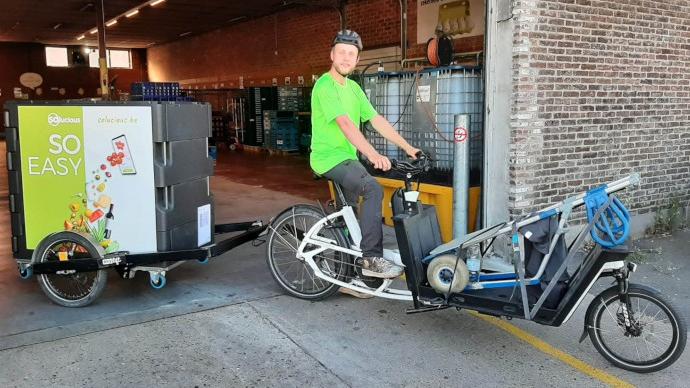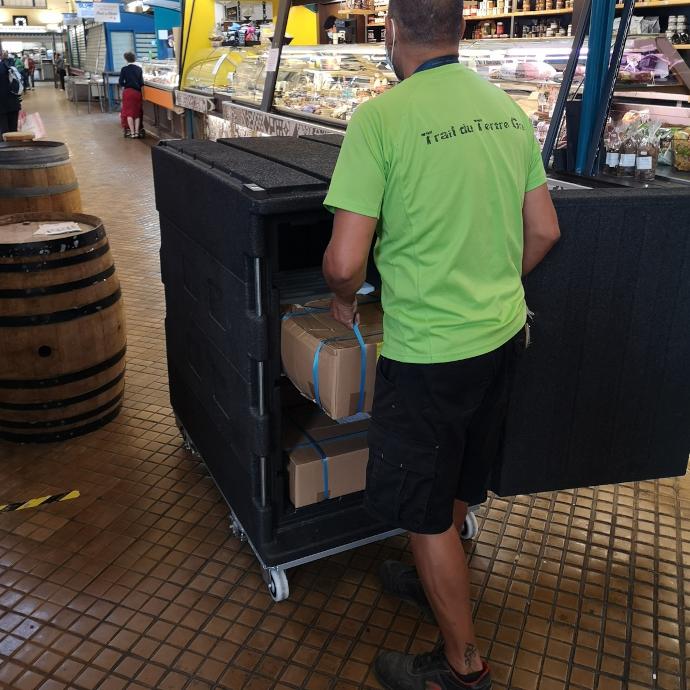Cyclo-logistics is undeniably on the rise. Public policies are no stranger to this. The creation of EPZs, the Mobility Orientation Law (LOM) and the Urban Transport Plan (PDU) are measures that encourage an ecological transition in the goods transport sector. New operators are emerging, creating a fragmented landscape that is struggling to be structured.
Cyclo-logistics is becoming the Eldorado of ultra-urban delivery, meeting the various constraints of the city: congestion, pollution and nuisance. The distribution of heat-sensitive foodstuffs is no exception to this transport medium. Nevertheless, this type of merchandise requires special treatment. Between knowledge of the regulations in force, health safety and logistical problems, the soft mobility of perishable foodstuffs remains a regulated sector but one that is not very well mastered. What do you need to know about foodtech by bike to start distributing small dishes or raw food?
1. Regulations
The transport of food products is organized by a private body mandated by the State, the Cémafroid. The latter has drawn up a set of regulations known as the ATP (Accord de Transport des Denrées Périssables - Agreement on the Transport of Perishable Foodstuffs), which sets out the legal framework for the transport of heat-sensitive food products. To help you understand the regulations, we've provided a summary of distribution temperatures for perishable foodstuffs. Please note that any inspection of your products at a temperature that does not comply with the regulations may result in criminal prosecution.
Categories of food | Storage temperature |
| Cooked fish, shellfish and mollusks, cooked meats, defrosting products, opened fresh products, ready-made meals, home-made products, etc. | Between 0° C et + 4° C |
| Raw meats, uncooked fish, cold cuts, pastries with cream, fresh products made from raw milk, cut-up cheeses, etc.. | Maximum +4° C |
| Ready-to-eat fruit and vegetables | + 4°C |
| Fresh dairy products, eggs, dairy desserts, butters and fats, etc.. | Between+ 6° C et + 8° C |
| All frozen foods | -12° C |
| Produits surgelés, glaces et sorbets | -18° C |
Transloading
Transloading happens when your refrigerated cabinet is opened during the tour to load or unload goods. Why is it taken into consideration? Because any opening necessarily implies a rise in temperature inside the cold cell. It is therefore necessary to ensure the isothermal performance of your equipment and also the energy output of your cold source. The combination of these two factors will allow you to considerably reduce the impact of this interruption of the cold chain on the product transported.
Yes, but how do I check the performance of my equipment?
→ Understood, but how can I check the performance of my equipment?
Cémafroid has drawn up a performance scale, called the K coefficient, according to the type of products transported: For the transport of frozen products, the K coefficient of your equipment must not exceed 0.4W/m2.K. For the transport of fresh products, this coefficient must not reach 0.7W/m2K.
Logistics
Multitasking oriented equipment
To equip oneself is to project oneself. It means imagining where the business could develop and making equipment choices that will allow you to modulate usage. The principle is simple: equip yourself with a tool that will allow you to adapt its use according to the context and customer demand. In the context of transporting perishable products, the questions to ask yourself are :
→ At what temperature should I transport my products?I transport fresh products between +2°C and +4°C: what if tomorrow the frozen food market grows?
→Does my equipment allow me to transport several temperature ranges?
To equip yourself is to think about simplifying your process. It is therefore relevant to ask yourself about the points of dependence of the system you wish to deploy. When transporting food products, the type of cold source is crucial. There are two types: active or a. Think autonomy, durability, reliability and profitability: make sure the cold is constant throughout the delivery period.
The technology used, which serves as the cold source, must be able to keep products cool for 8 consecutive hours. We need to be able to have a backup in case of unforeseen circumstances.
3. Standardised equipment
Logistics is governed by the use of standardised dimensions based on the Euro Pallet 800x1200 mm format. The variation of its multiples, half pallet, quarter pallet is also frequent. The distribution of perishable foodstuffs requires consideration of the packaging of the products transported. Of course, the distribution of single meals in kraft bags does not involve this reasoning, but if you wish to extend your activity to the distribution of groceries or to the restocking of certain mini-markets, it will be necessary to be equipped with a standardised fleet.
Ready to use equipment
Olivo Cold Logistics has adopted a modular approach to the design and manufacture of its products. ROLL O'CITY, which was designed to transport fresh and frozen products simultaneously and thus pool deliveries. Optimisation is the key to a profitable cyclo-logistics model.
t is on this principle that FlexiModal has developed the BicyLift, a smart trailer capable of carrying any load with the dimensions of a Euro Pallet. Isothermal containers, platforms and other bulky parcels can be transported with ease..
Finally, distributing products that need to be transported at controlled temperatures calls for great vigilance, both in terms of equipment choices and regulatory knowledge. At a time when several players in the food distribution sector are under scrutiny for health safety issues, it seems vital to surround yourself with experts in logistics and refrigeration solutions.




